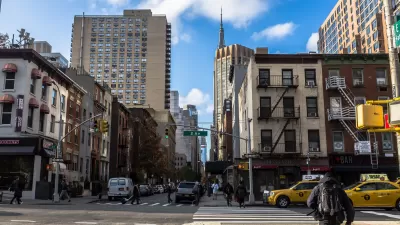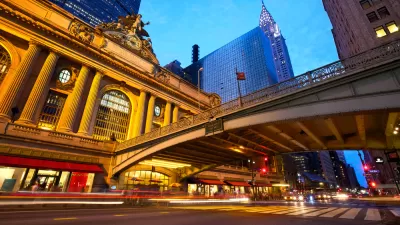Two position papers out this week present the opposing viewpoints in the contentious debate around New York's Midtown East rezoning. Should historic building protections in the area be expanded or should developers be allowed to maximize density?
As New York seeks to move along the proposed rezoning of dozens of blocks in close proximity to Grand Central Terminal before the end of the Bloomberg Administration, preservation and development advocates are staking out their positions on whether additional buildings in the area deserve landmark status.
According to David W. Dunlap, "Two position papers released Wednesday answered the question quite differently."
"In 'Icons, Placeholders and Leftovers: Midtown East Report' (PDF), the Real Estate Board of New York and its allies in the Midtown21C coalition concluded, 'The critical landmarks have been designated.' They rejected every building identified by preservation groups as being worthy of landmark consideration."
"At the same time, in the other position paper, 'East Midtown: A Bold Vision for the Future' (PDF), the Municipal Art Society of New York said that in the area to be rezoned, only 32 of 587 buildings were now landmarks, and that 17 other buildings were prime candidates for landmark status," notes Dunlap.
“Today’s businesses want talent,” the art society said in its report, “and increasingly, talent gravitates toward neighborhoods that are real places — with walkable streets, unique architecture, great restaurants and other opportunities for socializing and amusement.”
FULL STORY: 2 Views of Buildings Around Grand Central: Special or Just Old

Maui's Vacation Rental Debate Turns Ugly
Verbal attacks, misinformation campaigns and fistfights plague a high-stakes debate to convert thousands of vacation rentals into long-term housing.

Planetizen Federal Action Tracker
A weekly monitor of how Trump’s orders and actions are impacting planners and planning in America.

In Urban Planning, AI Prompting Could be the New Design Thinking
Creativity has long been key to great urban design. What if we see AI as our new creative partner?

King County Supportive Housing Program Offers Hope for Unhoused Residents
The county is taking a ‘Housing First’ approach that prioritizes getting people into housing, then offering wraparound supportive services.

Researchers Use AI to Get Clearer Picture of US Housing
Analysts are using artificial intelligence to supercharge their research by allowing them to comb through data faster. Though these AI tools can be error prone, they save time and housing researchers are optimistic about the future.

Making Shared Micromobility More Inclusive
Cities and shared mobility system operators can do more to include people with disabilities in planning and operations, per a new report.
Urban Design for Planners 1: Software Tools
This six-course series explores essential urban design concepts using open source software and equips planners with the tools they need to participate fully in the urban design process.
Planning for Universal Design
Learn the tools for implementing Universal Design in planning regulations.
planning NEXT
Appalachian Highlands Housing Partners
Mpact (founded as Rail~Volution)
City of Camden Redevelopment Agency
City of Astoria
City of Portland
City of Laramie




























